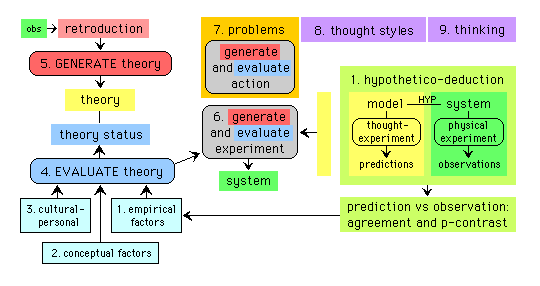Friday, May 27, 2005
Thinking about Thinking, Part 1 of 4
I have been invited to a roundtable discussion on thinking about thinking. I interpret this to mean how one can learn to think better or what one can do to practice to think better.
One idea is to use a thinking framework or tool. The hallmark of modern western thinking derives from Aristotle's deductive logic and Bacon's inductive logic combined into Galileo's scientific method. Using this framework should not be overlooked.
The simplest and maybe most widely used thinking tool is the journalist framework: who, what, when, where, why, and how.
Zachman put this journalist framework in the columns of a matrix and added reference perspectives in the rows of the matrix to create a framework for use in thinking through enterprise architecture. Modifying the reference perspectives, or the artifacts in the cells to the problem at hand would yield a very robust thinking framework.
Another good thinking framework is De Bono's Six Thinking Hats. Mindtools.com summarizes these as follows:
[continued in part 2 . . .]
One idea is to use a thinking framework or tool. The hallmark of modern western thinking derives from Aristotle's deductive logic and Bacon's inductive logic combined into Galileo's scientific method. Using this framework should not be overlooked.
graphic by Craig Rusbult
The simplest and maybe most widely used thinking tool is the journalist framework: who, what, when, where, why, and how.
Zachman put this journalist framework in the columns of a matrix and added reference perspectives in the rows of the matrix to create a framework for use in thinking through enterprise architecture. Modifying the reference perspectives, or the artifacts in the cells to the problem at hand would yield a very robust thinking framework.
Another good thinking framework is De Bono's Six Thinking Hats. Mindtools.com summarizes these as follows:
- White Hat:
With this thinking hat you focus on the data available. Look at the information you have, and see what you can learn from it. Look for gaps in your knowledge, and either try to fill them or take account of them. This is where you analyze past trends, and try to extrapolate from historical data.
- Red Hat:
'Wearing' the red hat, you look at problems using intuition, gut reaction, and emotion. Also try to think how other people will react emotionally. Try to understand the responses of people who do not fully know your reasoning.
- Black Hat:
Using black hat thinking, look at all the bad points of the decision. Look at it cautiously and defensively. Try to see why it might not work. This is important because it highlights the weak points in a plan. It allows you to eliminate them, alter them, or prepare contingency plans to counter them.
Yellow Hat:
The yellow hat helps you to think positively. It is the optimistic viewpoint that helps you to see all the benefits of the decision and the value in it. Yellow Hat thinking helps you to keep going when everything looks gloomy and difficult.
- Green Hat:
The Green Hat stands for creativity. This is where you can develop creative solutions to a problem. It is a freewheeling way of thinking, in which there is little criticism of ideas. A whole range of creativity tools can help you here.
- Blue Hat:
The Blue Hat stands for process control. This is the hat worn by people chairing meetings. When running into difficulties because ideas are running dry, they may direct activity into Green Hat thinking. When contingency plans are needed, they will ask for Black Hat thinking, etc.
[continued in part 2 . . .]





